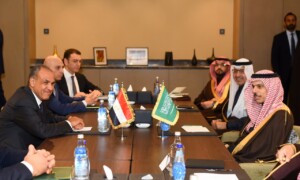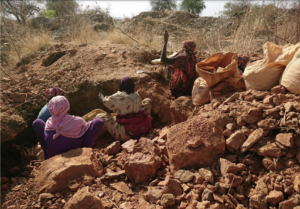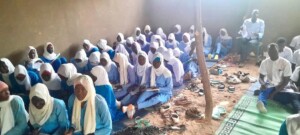Sudan OCHA bulletin 14: Response to acute watery diarrhoea
According to the latest information from the Sudanese Ministry of Health and the World Health Organization (WHO), between mid-August 2016 and 9 June 2017 about 16,600 suspected cases of Acute Watery Diarrhoea (AWD) were reported in Sudan, including 317 deaths.
According to the latest information from the Sudanese Ministry of Health and the World Health Organization (WHO), between mid-August 2016 and 9 June 2017 about 16,600 suspected cases of Acute Watery Diarrhoea (AWD) were reported in Sudan, including 317 deaths.
The Health Ministry and the World Health Organization (WHO) report that the National Acute Watery Diarrhoea (AWD) Preparedness and Response Plan for 2017-2018 was endorsed and signed by Ministry and distributed to all health partners.
Overall 79 localities in 12 states are affected, including Blue Nile state, Sennar, El Gedaref, Kassala, Red Sea state, River Nile, Northern State, Khartoum, El Gezira, White Nile state, South Kordofan, and North Kordofan, the UN Office for the Coordination of Humanitarian Affairs (OCHA) in Sudan reported in its latest news bulletin.
The active AWD response has been scaled up through engaging all sectors, civil society and NGOs, including media, with support from WHO, the UN Children’s Fund (Unicef) and the Sudanese Red Crescent Society (SRCS) to implement interventions such as ensuring safe water, early detection, case management, health education and sanitation.
WHO has deployed a national epidemiologist to follow-up on the AWD outbreak in Khartoum. Four main hospitals in Khartoum were visited jointly by the Ministry and WHO to identify immediate gaps and address health service provision through treatment centres.
WHO and the Ministry are planning to launch community-based actions in order to enhance self-reliance of the affected communities and ensure the prevention of AWD in a more sustainable manner.
A pilot training on community-based actions will be launched in White Nile state on 21 and 22 June. In addition, WHO has launched an early warning alert and response system in camps hosting South Sudanese refugees to quickly identify potential outbreaks and any other health threats, and provide an effective and rapid response.
Unicef and partners have supported the treatment of more than 4,000 suspected cases of AWD in White Nile state. They provided lifesaving water supplies to about 800,000 people at risk in the areas affected by AWD in the state.
Cases of AWD have also been reported in South Kordofan. As a preventative measure WHO supported the Sudanese Ministry of Health to successfully carry out a cholera vaccination campaign for refugee and host communities in Abu Jubaiha and El Leri localities.
Assistance reaches displaced in Um Dukhun
Humanitarian partners are responding to the needs of about 4,000 displaced people who fled Salamat-Misseriya clashes in April and May in Central Darfur’s Um Dukhun locality.
The World Food Programme (WFP) and Catholic Relief Services provided a three-month emergency food distribution. Unicef in collaboration with the Central Darfur Ministry of Education has enrolled 920 children in schooling, and distributed education supplies for 1,720 emergency affected school age children.
Sudan Humanitarian Fund allocates $1 million for response in North Darfur’s El Laeet
The Sudan Humanitarian Fund (SHF) Reserve for Emergencies has allocated $1 million to scale up existing services to respond to the needs of about 16,400 displaced East Darfuris and South Sudanese refugees, who settled with host communities in North Darfur’s El Laeet locality following herders-farmers clashes in East Darfur earlier this year.
This SHF allocation will fund the operation of six health facilities run by Save the Children and the Sudanese Community Development Organisation, the drilling of two water yards that will increase the water supply in the area, the construction of distribution points by the Cooperazione Internazionale, and purchasing of emergency shelter material to be distributed by the Sudanese Sustainable Action Group.
Islamic Relief Worldwide assists South Sudanese refugees in West Kordofan

Islamic Relief Worldwide (IRW) assisted about 3,000 South Sudanese refugees and 300 vulnerable 1,500 people from the host community in West Kordofan’s El Meiram.
The organisation has distributed emergency household supplies including jerry cans, buckets, cups and water pots. Funding for this assistance was provided through the SHF.
IRW has distributed hygiene kits, trained 60 hygiene promoters, distributed 180 waste collection sets, and provided cleaning tools to assist the community to carry out periodic cleaning campaigns.
IRW is also planning to assist newly arrived South Sudanese refugees in El Leri in South Kordofan through food distribution for about 5,000 people in Ramadan.
High rates of malnutrition in Jebel Marra
A recent survey conducted in Jebel Marra in Central Darfur identified critical levels of acute malnutrition with a Global Acute Malnutrition (GAM) rate of 15.7 percent and Severe Acute Malnutrition (SAM) of 5 percent, according to Unicef.
Unicef is taking the lead with the federal and state-level Ministry of Health in mobilising an inter-sectoral response for approximately 200,000 displaced or newly returned people, including an estimated 120,000 children, in the Jebel Marra area.
Joint Resilience-Building Project in Kassala reaches over 263,500 people
WFP, alongside the Food and Agriculture Organization (FAO) and Unicef continue the implementation of a Joint Resilience-Building Project in Kassala, which provides 263,510 people with assistance.
The project, funded by the UK Department for International Development, started in September 2014 and will end in August 2017. As of December 2015, stunting in children was reduced by 9 percent in the targeted localities of Aroma, Hamashkoreib, North Delta and Telkok
About 1,200 women were trained in literacy and numeracy. In addition, women’s presence and membership in development committees and local assemblies has also increased.
The percentage of households cultivating crops or doing home gardening has increased by 20 percent since 2015, mainly due to the timely provision of inputs/tools by the project, availability of water and good rain.











 and then
and then